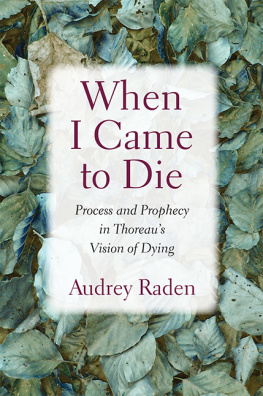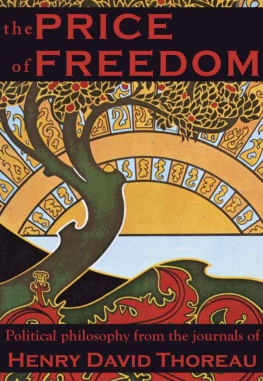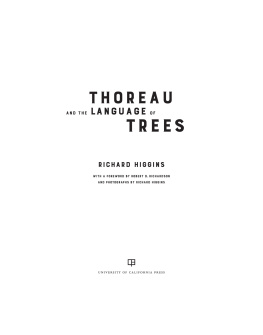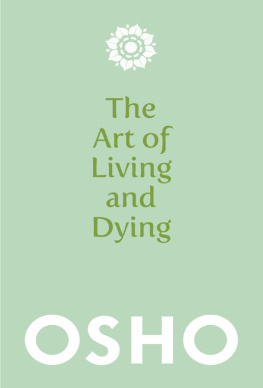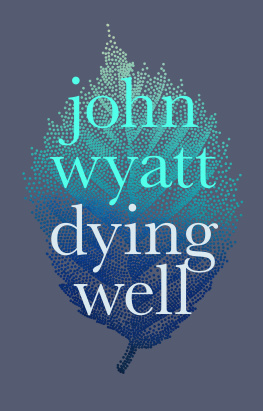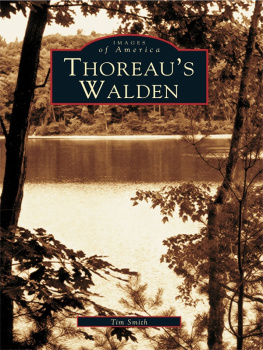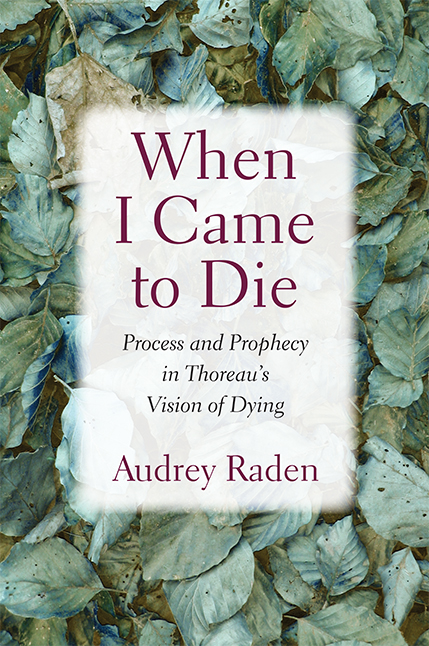
When I Came to Die
When I Came to Die
Process and Prophecy in Thoreaus Vision of Dying
Audrey Raden
University of Massachusetts Press
Amherst and Boston
Copyright 2017 by University of Massachusetts Press
All rights reserved
Printed in the United States of America
ISBN 978-1-61376-476-3
Cover design by Jack Harrison
Cover art: Digitally altered photo of autumn leaves Abdul Sami Haqqani | Dreamstime.
Library of Congress Cataloging-in-Publication Data
A catalog record for this book is available from the Library of Congress.
British Library Cataloguing-in-Publication Data
A catalog record for this book is available from the British Library.
For
Joseph S. Raden
19132008
and
Frederick M. Hull
19572013
May their memory be for a blessing.
I went to the woods because I wished to live deliberately, to front only the essential facts of life, and see if I could not learn what it had to teach, and not, when I came to die, discover that I had not lived.
Henry David Thoreau, Walden
Contents
This book began its life in May 2002. Early in that month, I traveled alone for the first time to Concord, Massachusetts, in time for the anniversary of Thoreaus death. I sniffed the last of the apple blossoms, walked to Walden Pond and Sleepy Hollow Cemetery, and in general enjoyed being a pilgrim of transcendentalism. Fortunately, the last day of my trip was rainy, so that I got to spend the entire day in the Concord Free Public Library. I looked at the paintings, busts, and plaques, stared reverently at Daniel Chester Frenchs sculpture of Emerson, and then sat down to write.
Thoreaus late essays had inspired me to write about his approach to the process of dying. I have always been drawn to writings about the end of life (no doubt because of all the Victorian novels I have read), and I was struck by the similarity of the imagery that Thoreau used to describe both the death of John Brown and the death of the year. The fact that he wrote about them so close to his own death piqued my imagination further. As I began my research, I discovered that no one had ever written a full-length study on Thoreau and dying. In fact, very few articles even discussed it. A book needed to be written.
My first thanks must go to Sarah Lazarus and Ken Lazarus, the owners of the lovely Yellow House on Main Street in Concord, where Thoreau lived for the last twelve years of his life and where he died. As I was close to finishing this book in January 2013, they graciously gave me, a stranger, a tour, allowed me to see his attic study and the front parlor where he died. This visit helped my work immensely.
I thank David Reynolds, my intellectual mentor at the City University of New Yorks graduate school, who never gave up on my endeavors, even when I was ready to give up on them myself; as well as Robert A. Gross, who began as an outside reader and became a dear friend. It was he who introduced my manuscript to the University of Massachusetts Press. I am grateful to my editors at the press, Clark Dougan, Matt Becker, and Carol Betsch, Karen Fisk, and my copyeditor, Dawn Potter, who were infinitely patient with me. I also thank my first reader, Jeffrey Berman, for his kind encouragement and my anonymous second reader, who helped me refine my draft into a book.
My research benefited from the patient assistance of Leslie Perrin Wilson, the Special Collections curator at the Concord Free Public Library and her staff assistant, Constance Minoli-Skocay; Jeffrey Cramer, curator of the Thoreau Institute in Lincoln, Massachusetts; and David F. Wood, curator of the Concord Museum. The faculty and staff of New York Theological Seminary made it possible for me to finish this book while completing a masters degree in divinity. Special thanks go to Dale Irvin, Jin Hee Han, Ava Carroll, Jerry Reisig, Jill Schaeffer, and Lillian Rodriguez.
I am grateful for the insights, guidance, and good fellowship of the members of the Thoreau and Emerson societies, particularly Phyllis Cole, Robert Hudspeth, the late Bradley P. Dean, the late Edmund Schofield, Michael Schliefer, Mike Frederick, Laura Dassow Walls, Sandra Herbert Petrolionus, Kevin Van Anglan, John Matteson, Richard Smith, Peter Alden, Dianne McConville Weiss, and Victor Curran. In addition, as Emerson said of Thoreau, my dear friends never faltered, and their brilliance and encouragement have been a pleasure and a gift: Marvin Lifschitz, Patrick Martin, Victoria Wolfson, Louis Asekoff, Greg Wilson, Vickie Wilson, Rachel Ihara, Jaime Cleland, Vincent Sanchez, Mitchell Lichtenstein, Miguel Arisa, Carter Johnson, Jonathan Golby, David Kaplan, Marilyn Mudry, Gregory Burch, and especially my beloved editorial elves and writing partners Jenny Weiss, T. Meyerhoff, and Cori L. Gabbard.
I also thank my family, my kitty muse Increase, and especially My Dear and Loving Husband John Eiche:
If ever two were one, then surely we.
If ever man were loved by wife, then thee:
If ever wife were happy in a man,
Compare with me ye women if you can.
When I Came to Die
Anticipation as Prophecy
It is not important that [a man] should mature as an apple-tree or oak. Shall he turn his spring into summer?
Henry David Thoreau, Walden
I
Nature is always dying; Henry David Thoreau knew this and spent his entire life saying good-bye. Of course, he knew that nature is also always living; but beautifully and paradoxically, he was able to portray dying as the truest form of living. Likewise, though this book is ostensibly about the theme of dying in Thoreaus writings, it focuses on a particular transitionthe nontemporal, nonspatial existence between two states that is neither one nor the other. For Thoreau, that state exists primarily in the process of dying. Dying is continual and integral to creation. To be dead is to step out of the innocent cycles of nature, whereas to be dyingreally dying, as he writes in Waldenis to be continually participating in nature.
One cannot fairly call Thoreau death-obsessed, for he lived in a culture that was deeply invested in death and in dying well. In his vast and brilliant study The Hour of Our Death, Philippe Aris posits that in the nineteenth century, as interest in a traditional notion of salvation began to fade, emphasis shifted to the actual moment of death, when the soul parted from the body and the dying person separated from loved ones.
This idea of the beautiful death was familiar to both the Emerson and the Thoreau families. After Thoreaus brother John died agonizingly of lockjaw in January 1842, Ralph Waldo Emersons wife Lidian wrote to her sister Lucy Jackson Brown: Its a beautiful fate that has been granted him and I think he was worthy of it Later in the month, still thinking about Johns death, she wrote to her sister again: During the hour in which he died, he looked at Henry with a transcendent smile full of heaven... and Henry found himself returning it and this was the last communication that passed between them. Such epistolary recordings of deathbed scenes were common in the antebellum period.
In his classic essay Death in the Popular Mind of PreCivil War America, Lewis O. Saum writes, The acme of privilege came in witnessing a triumphant death. In the abstract, one encounters the contention that holy dying represented the logical finality of holy living. In fact, however, much of what we know about Thoreaus dying was recorded by his fellow transcendentalists, especially in letters written by the well-educated Sophia.
Next page
